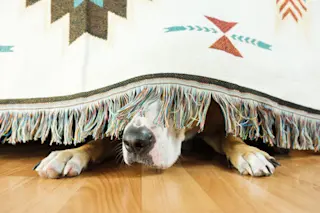My golden retriever Angus can feel a thunderstorm coming when it's still hundreds of miles away. He starts panting, shaking and walking from room to room, trying to find a safe place to hide. And he's not alone. Dogs are more sensitive to loud sounds compared to humans, and they may also be more aware of changes in air pressure that occur when a storm is coming. According to experts, dogs are instinctual, so while they might not realize why they're scared, they can sense a threat is close by.
But it's not just storms that make our pets nervous. Going to the veterinarian, riding in a car and meeting strangers can all have the same impact, depending on the animal. So how do you know whether your pet is anxious, and what should you do about it?
Read More: Why Some Dogs Fear Fireworks and What To Do
Kristi ...















